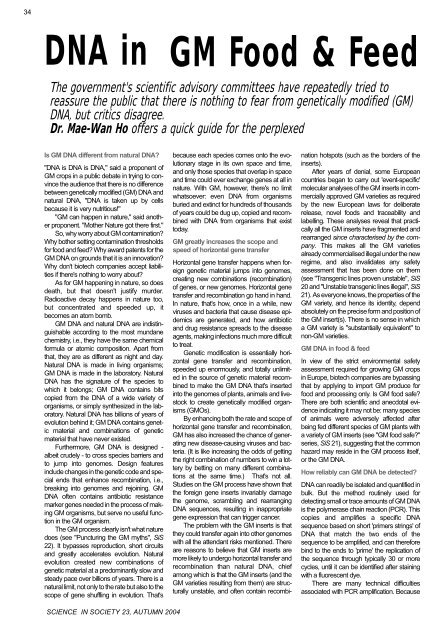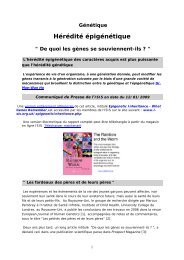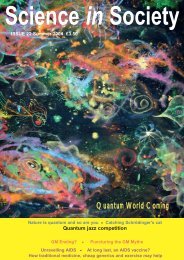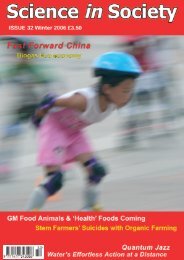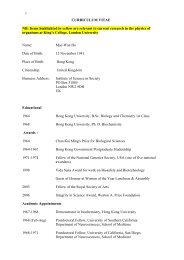Ethiopia goes organic to feed herself - The Institute of Science In ...
Ethiopia goes organic to feed herself - The Institute of Science In ...
Ethiopia goes organic to feed herself - The Institute of Science In ...
Create successful ePaper yourself
Turn your PDF publications into a flip-book with our unique Google optimized e-Paper software.
34<br />
DNA in GM Food & Feed<br />
<strong>The</strong> government's scientific advisory committees have repeatedly tried <strong>to</strong><br />
reassure the public that there is nothing <strong>to</strong> fear from genetically modified (GM)<br />
DNA, but critics disagree.<br />
Dr. Mae-Wan Ho <strong>of</strong>fers a quick guide for the perplexed<br />
Is GM DNA different from natural DNA?<br />
"DNA is DNA is DNA," said a proponent <strong>of</strong><br />
GM crops in a public debate in trying <strong>to</strong> convince<br />
the audience that there is no difference<br />
between genetically modified (GM) DNA and<br />
natural DNA, "DNA is taken up by cells<br />
because it is very nutritious!"<br />
"GM can happen in nature," said another<br />
proponent. "Mother Nature got there first."<br />
So, why worry about GM contamination?<br />
Why bother setting contamination thresholds<br />
for food and <strong>feed</strong>? Why award patents for the<br />
GM DNA on grounds that it is an innovation?<br />
Why don't biotech companies accept liabilities<br />
if there's nothing <strong>to</strong> worry about?<br />
As for GM happening in nature, so does<br />
death, but that doesn't justify murder.<br />
Radioactive decay happens in nature <strong>to</strong>o,<br />
but concentrated and speeded up, it<br />
becomes an a<strong>to</strong>m bomb.<br />
GM DNA and natural DNA are indistinguishable<br />
according <strong>to</strong> the most mundane<br />
chemistry, i.e., they have the same chemical<br />
formula or a<strong>to</strong>mic composition. Apart from<br />
that, they are as different as night and day.<br />
Natural DNA is made in living organisms;<br />
GM DNA is made in the labora<strong>to</strong>ry. Natural<br />
DNA has the signature <strong>of</strong> the species <strong>to</strong><br />
which it belongs; GM DNA contains bits<br />
copied from the DNA <strong>of</strong> a wide variety <strong>of</strong><br />
organisms, or simply synthesized in the labora<strong>to</strong>ry.<br />
Natural DNA has billions <strong>of</strong> years <strong>of</strong><br />
evolution behind it; GM DNA contains genetic<br />
material and combinations <strong>of</strong> genetic<br />
material that have never existed.<br />
Furthermore, GM DNA is designed -<br />
albeit crudely - <strong>to</strong> cross species barriers and<br />
<strong>to</strong> jump in<strong>to</strong> genomes. Design features<br />
include changes in the genetic code and special<br />
ends that enhance recombination, i.e.,<br />
breaking in<strong>to</strong> genomes and rejoining. GM<br />
DNA <strong>of</strong>ten contains antibiotic resistance<br />
marker genes needed in the process <strong>of</strong> making<br />
GM organisms, but serve no useful function<br />
in the GM organism.<br />
<strong>The</strong> GM process clearly isn't what nature<br />
does (see "Puncturing the GM myths", SiS<br />
22). It bypasses reproduction, short circuits<br />
and greatly accelerates evolution. Natural<br />
evolution created new combinations <strong>of</strong><br />
genetic material at a predominantly slow and<br />
steady pace over billions <strong>of</strong> years. <strong>The</strong>re is a<br />
natural limit, not only <strong>to</strong> the rate but also <strong>to</strong> the<br />
scope <strong>of</strong> gene shuffling in evolution. That's<br />
because each species comes on<strong>to</strong> the evolutionary<br />
stage in its own space and time,<br />
and only those species that overlap in space<br />
and time could ever exchange genes at all in<br />
nature. With GM, however, there's no limit<br />
whatsoever: even DNA from organisms<br />
buried and extinct for hundreds <strong>of</strong> thousands<br />
<strong>of</strong> years could be dug up, copied and recombined<br />
with DNA from organisms that exist<br />
<strong>to</strong>day.<br />
GM greatly increases the scope and<br />
speed <strong>of</strong> horizontal gene transfer<br />
Horizontal gene transfer happens when foreign<br />
genetic material jumps in<strong>to</strong> genomes,<br />
creating new combinations (recombination)<br />
<strong>of</strong> genes, or new genomes. Horizontal gene<br />
transfer and recombination go hand in hand.<br />
<strong>In</strong> nature, that's how, once in a while, new<br />
viruses and bacteria that cause disease epidemics<br />
are generated, and how antibiotic<br />
and drug resistance spreads <strong>to</strong> the disease<br />
agents, making infections much more difficult<br />
<strong>to</strong> treat.<br />
Genetic modification is essentially horizontal<br />
gene transfer and recombination,<br />
speeded up enormously, and <strong>to</strong>tally unlimited<br />
in the source <strong>of</strong> genetic material recombined<br />
<strong>to</strong> make the GM DNA that's inserted<br />
in<strong>to</strong> the genomes <strong>of</strong> plants, animals and lives<strong>to</strong>ck<br />
<strong>to</strong> create genetically modified organisms<br />
(GMOs).<br />
By enhancing both the rate and scope <strong>of</strong><br />
horizontal gene transfer and recombination,<br />
GM has also increased the chance <strong>of</strong> generating<br />
new disease-causing viruses and bacteria.<br />
(It is like increasing the odds <strong>of</strong> getting<br />
the right combination <strong>of</strong> numbers <strong>to</strong> win a lottery<br />
by betting on many different combinations<br />
at the same time.) That's not all.<br />
Studies on the GM process have shown that<br />
the foreign gene inserts invariably damage<br />
the genome, scrambling and rearranging<br />
DNA sequences, resulting in inappropriate<br />
gene expression that can trigger cancer.<br />
<strong>The</strong> problem with the GM inserts is that<br />
they could transfer again in<strong>to</strong> other genomes<br />
with all the attendant risks mentioned. <strong>The</strong>re<br />
are reasons <strong>to</strong> believe that GM inserts are<br />
more likely <strong>to</strong> undergo horizontal transfer and<br />
recombination than natural DNA, chief<br />
among which is that the GM inserts (and the<br />
GM varieties resulting from them) are structurally<br />
unstable, and <strong>of</strong>ten contain recombination<br />
hotspots (such as the borders <strong>of</strong> the<br />
inserts).<br />
After years <strong>of</strong> denial, some European<br />
countries began <strong>to</strong> carry out 'event-specific'<br />
molecular analyses <strong>of</strong> the GM inserts in commercially<br />
approved GM varieties as required<br />
by the new European laws for deliberate<br />
release, novel foods and traceability and<br />
labelling. <strong>The</strong>se analyses reveal that practically<br />
all the GM inserts have fragmented and<br />
rearranged since characterised by the company.<br />
This makes all the GM varieties<br />
already commercialised illegal under the new<br />
regime, and also invalidates any safety<br />
assessment that has been done on them<br />
(see "Transgenic lines proven unstable", SiS<br />
20 and "Unstable transgenic lines illegal", SiS<br />
21). As everyone knows, the properties <strong>of</strong> the<br />
GM variety, and hence its identity, depend<br />
absolutely on the precise form and position <strong>of</strong><br />
the GM insert(s). <strong>The</strong>re is no sense in which<br />
a GM variety is "substantially equivalent" <strong>to</strong><br />
non-GM varieties.<br />
GM DNA in food & <strong>feed</strong><br />
<strong>In</strong> view <strong>of</strong> the strict environmental safety<br />
assessment required for growing GM crops<br />
in Europe, biotech companies are bypassing<br />
that by applying <strong>to</strong> import GM produce for<br />
food and processing only. Is GM food safe?<br />
<strong>The</strong>re are both scientific and anecdotal evidence<br />
indicating it may not be: many species<br />
<strong>of</strong> animals were adversely affected after<br />
being fed different species <strong>of</strong> GM plants with<br />
a variety <strong>of</strong> GM inserts (see "GM food safe?"<br />
series, SiS 21), suggesting that the common<br />
hazard may reside in the GM process itself,<br />
or the GM DNA.<br />
How reliably can GM DNA be detected?<br />
DNA can readily be isolated and quantified in<br />
bulk. But the method routinely used for<br />
detecting small or trace amounts <strong>of</strong> GM DNA<br />
is the polymerase chain reaction (PCR). This<br />
copies and amplifies a specific DNA<br />
sequence based on short 'primers strings' <strong>of</strong><br />
DNA that match the two ends <strong>of</strong> the<br />
sequence <strong>to</strong> be amplified, and can therefore<br />
bind <strong>to</strong> the ends <strong>to</strong> 'prime' the replication <strong>of</strong><br />
the sequence through typically 30 or more<br />
cycles, until it can be identified after staining<br />
with a fluorescent dye.<br />
<strong>The</strong>re are many technical difficulties<br />
associated with PCR amplification. Because<br />
SCIENCE IN SOCIETY 23, AUTUMN 2004


